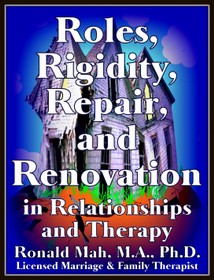1. Roles, Hierarchy, & Re-Structuring - RonaldMah
Ronald Mah, M.A., Ph.D.

Licensed Marriage & Family Therapist,
Consultant/Trainer/Author
Main menu:
1. Roles, Hierarchy, & Re-Structuring
Therapist Resources > Therapy Books > Roles Rigidity Repair in Relationships

Roles, Rigidity, Repair, and Renovation in Relationships and Therapy
Chapter 1: ROLES, HIERARCHY, & RE-STRUCTURING
by Ronald Mah

Each family or system has its own set of relational skills and patterns of behavior patterns shared by its members. These skills and patterns are determined, developed, and adapted to enable individuals in the family to move toward goals intended for the well-being of the family as a whole. Relative well-being is subjective within the family and includes how well it adapts to changing challenges developmentally and in larger social contexts. The relationship, couple, or family continues to evolve throughout its existence and can be evaluated according to how well members "contribute to the facilitation of growth, well-being, and satisfaction of all family members; encourage the mutual advancement of community and family; and secure the achievement of reality-based developmentally appropriate needs and goals of the family unit (Morris and Blanton, 1998, page 28). These common goals guide individual members' behaviors within the relationship, couple, or family. Family is defined as "a group of individuals who are related to each other by quasi-circular relationships based on marriage or blood ties" (Simadi et al, 2003 page 467). There are often three subsystems: parents, children, and siblings. Each subsystem has its own boundaries. The characteristics of the couple's system and a sibling system will be different. Within any system, system members reciprocally affect one another in a multitude of ways- hence, the quasi-circular aspect. The larger family system develops and grows in order to accept new members such as the birth of a new baby. Birth of children would involve significant lifestyle change. The system as a whole is more important than any of its individual parts or members. As a result, individual opinions or experiences may differ from the family opinion or experience.
Structural therapy that attempts to alter the relationship, couple, or family arrangement inevitably exposes and runs into a multitude of important dynamics. Zimmerman (2000) notes that "in Gottman's (1999) 25 years of research described in his book, Principles for Successful Marriages, none of the principles have to do with family arrangements" (page 252). Instead they involve sharing of power, accepting influence, communication, respecting each other, deep friendship, and knowing each other and the details of each other's lives. Gottman's principles for marital satisfaction do not explicitly address the structure of the relationship, couple, or family. However, the principles of structural therapy are fully compatible with Gottman's and other couple's theorists as they all address the functionality of the system.
Systems, including couples, families, work groups, and communities are more or less functional- that is, successful in taking care of its needs and reaching its goals depending on how well organized they are.
Functional systems include:
1. clear effective hierarchy of authority;2. well-defined roles;3. prescribed and actuated channels of communication;4. appropriate and respected boundaries; and5. appropriate alignments.
Families or couples, relationships or systems lose functionality when:
1. an individual or individuals acquire and exercise power outside of their position on the family or system hierarchy;2. an individual or individuals fails to exercise the power and authority of their position on the family or system hierarchy. A power and authority vacuum is created that may be unfilled, which creates tension, or may be filled inappropriately and/or by an inappropriate person;3. roles are poorly defined or ambiguous, or ill-suited to the individual, or too rigid (lacking flexibility), or defined inappropriately;4. communication channels are ignored or subverted or are poorly defined, or are skipped. For example, a third person is used to convey communication; a staff person complains to his or her supervisor's supervisor without first talking to his or her supervisor; when a child complains about one parent to another parent; when a child enlists siblings instead of directly communicating with the other sibling he or she disagrees with, and so forth;5. boundaries are too rigid for safe appropriate contact and communication;6. boundaries are too enmeshed to separate ones feelings and needs from another's;7. inappropriate coalitions exist. Examples would include a coalition between a teacher and a parent board member against administrative staff; between a parent and a child against another child; between a parent and a child against the other parent. Examples of what could be appropriate alignments would be the parents together against a child, or the males against the females.
Structural therapy has important conceptualizations. They are useful for diagnosis and assessment and directly guide treatment or interventions.
1. Family/System Structure: The governing rules of a family/system, in particular a guide for the transactional patterns that occur between a family's individual members.2. Sub-systems: Components of a whole family system (or organization), which keep the system functioning by performing various sub-tasks (e.g. executive, daycare, nurturing, organizing, explaining, problem solving, parent relations, and so forth).3. Boundaries and Degree of Permeability: Barriers or boundaries within a family/system define its subsystems. Boundaries are rigid, diffuse, or clear. Ideally boundaries should be clear.
a. Enmeshment: Results when boundaries are diffuse or highly permeable. Enmeshment leads to over-involvement and over-concern, and a lack of autonomy or independence of individual members.b. Disengagement: Results from rigid boundaries. Disengagement leads to separateness, distance, under-involvement and, often betrayal.
4. Alignments: How individual family members/staff group themselves or challenge one another in performing family/system tasks.
a. Triangles: A dysfunctional alignment of three family members/staff, which results from chronic boundary problems. When one subsystem deflects its tensions onto a third individual, this can cause the boundaries of that subsystem to become diffuse.
5. Power: Determined by (a) authority or who is making the decisions in the family/system and (b) responsibility or who is carrying out those decisions.6. Coalitions: An alignment of specific family members/staff against a third member.
a. Stable: A constant coalition, typically one parent and a child against the other parent (for example, one executive and a staff person against another, or two staff persons against another).b. Detouring: A coalition in which the tensions between two members (usually the parents/executives) are masked by focusing on a third member.
7. Family/System Dysfunction: Individual symptomology or system problems, resulting from a dysfunctional family/system structure.
Application of these principles and definitions to the human-canine system gives clear goals to restore the humans to their respective hierarchal roles and sets Chipper the dog in his role! A case can be made that Cesar Millan practices structural family therapy by asserting the alpha role with his canine charges and in his interventions with households with problematic dog behavior! Putting the dogs in their places more or less is his treatment. Obviously, people such as Penny, Dermot, and their children are more complex but the basic foundations for healing are quite similar.

